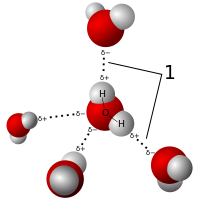
Photo from wikipedia
AbstractCarbonic acid dimer, (CA)2, (H2CO3)2, helps to explain the existence of this acid as a stable species, different to a simple sum between carbon dioxide and water. Five distinct, well… Click to show full abstract
AbstractCarbonic acid dimer, (CA)2, (H2CO3)2, helps to explain the existence of this acid as a stable species, different to a simple sum between carbon dioxide and water. Five distinct, well characterized types of intermolecular interactions contribute to the stabilization of the dimers, namely, C=O⋯H–O, H–O⋯H–O, C=O⋯C=O, C=O⋯O–H, and C–O⋯O–H. In many cases, the stabilizing hydrogen bonds are of at least the same strength as in the water dimer. We dissect the nature of intermolecular interactions and assess their influence on stability. For a set of 40 (H2CO3)2 isomers, C=O⋯H–O hydrogen bonds between the carbonyl oxygen in one CA molecule and the acidic hydrogen in the hydroxyl group at a second CA molecule are the major stabilizing factors because they exhibit the shortest interaction distances, the largest orbital interaction energies, and the largest accumulation of electron densities around the corresponding bond critical points. In most cases, these are closed-shell hydrogen bonds, however, in a few instances, some covalent character is induced. Bifurcated hydrogen bonds are a common occurrence in the dimers of carbonic acid, resulting in a complex picture with multiple orbital interactions of various strengths. Two anti–anti monomers interacting via the strongest C=O⋯H–O hydrogen bonds are the ingredients for the formation of the lowest energy dimers. Graphical AbstractCarbonic acid dimer, (CA)2, (H2CO3)2, helps explaining the existence of this acid as a stable species, different to a simple sum between carbon dioxide and water. Five distinct, well-characterized types of intermolecular interactions contribute to the stabilization of the dimers, namely, C=O⋯H–O, H–O⋯O–H, C=O⋯C=O, C=O⋯O–C, and C–O⋯O–C. In many cases, the stabilizing hydrogen bonds are of at least the same strength as in the water dimer.
Journal Title: Journal of Molecular Modeling
Year Published: 2019
Link to full text (if available)
Share on Social Media: Sign Up to like & get
recommendations!